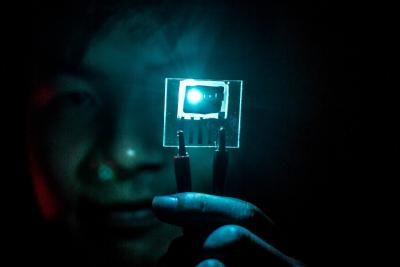OLED emitter materials are the heart of the OLED device, and the materials that make the most impact on the performance of the OLED display. Most OLED displays utilize red, green and blue emitters.
The efficiency of the current state-of-the-art commercial red and green OLED emitters is excellent - it is in fact close to 100% internal quantum efficiency (IQE) which means that you cannot improve much on the efficiency of the emitter itself (there's still work to be done on getting the light out of the device). Blue OLED emission is a completely different story - current commercial blue emitters suffer from very low efficiency, around 25%. This means that three quarters of the energy goes to waste. Changing to a 100% IQE blue emitter could end up improving the total display efficiency by 20-30%.
Over the years there have been intensive R&D efforts with an aim to develop more efficient blue OLED emitters. In this article we'll detail the leading efforts and the early stage companies and technologies that compete towards that goal. It is likely that the first-to-market blue OLED emitter material will be able to generate billions of dollars in revenue in the next 5-10 year.
An OLED emitter has to offer high performance across four main metrics: efficiency, color-point, lifetime and emission spectrum. And of course, be easy to synthesize. Achieving three metrics has been relatively easy for material developers, but designing a material that is efficient, long lasting and with a deep blue color point has been extremely challenging. To add to the complexity, the design of the complete OLED material stack has to be taken into account, not just the OLED emitter layer (i.e. also the host, ETL, EIL, HIL, and other layers). There are two main routes towards higher-efficiency blue emitters - based on either phosphorescence emission (Gen-2) or TADF/HF (Gen-3 / Gen-4) emission.
First up is leading OLED emitter producer Universal Display. Following years of intensive R&D, UDC is ready to release its first commercial phosphorescence blue emitter by the end of 2024. According to some reports, the first such emitters will suffer from a limited lifetime (around 50% compared to current blue emitters), which may limit their adoption. In any case, if UDC indeed launches the material by the end of the year, it is possible we'll see the first commercial displays that utilize an all-PHOLED OLED device during 2025. It is likely that the adoption of UDC's materials will be relatively quick as the company already lists almost all AMOLED producers as its customers.
 Second runner seems to be Japan-based Kyulux, developer of 4th-Gen Hyperfluorescence emitters is also reporting rapid progress, and the company stated that it expects to achieve a commercial blue HF emitter by 2025. Hyperfluorescence emitters are efficient and also offer a narrow emission spectrum, potentially giving them an edge over PHOLED emitters.
Second runner seems to be Japan-based Kyulux, developer of 4th-Gen Hyperfluorescence emitters is also reporting rapid progress, and the company stated that it expects to achieve a commercial blue HF emitter by 2025. Hyperfluorescence emitters are efficient and also offer a narrow emission spectrum, potentially giving them an edge over PHOLED emitters.
There are also several earlier stage companies, notably beeOLED and Noctiluca that develop blue OLED emitters using novel material platforms. It is likely that both companies will require at least 3-5 more years for the technology to mature. We estimate that at least $100 million is needed to design a new OLED emitter and commercialize it (if the R&D succeeds, that is). This is an expensive and complex operation that can take many years and require high-end R&D and chemical capabilities, the ability to produce many complete device samples, and strong business development and execution.
Several researchers around the world are looking into novel ideas to design new blue OLED emitters. In June 2024, for example, researchers from the University of Manchester, University of Cambridge and University of Eastern Finland, led by Dr. Alexander Romanov have developed a new deep-blue Carbene-Metal-Amide (CMA) OLED emitter material with promising operating lifetime. A month before, we reported that researchers from the UK and China developed a novel blue OLED emitter design, based on 5Cz-BO molecules, that offers highly efficient emission with a narrow emission spectrum. These are promising results - but these are very early stage efforts.
Many material developers and researchers are employing novel AI and Machine Learning technologies to help accelerate the material discovery process and to predict the performance of new molecules. These technologies and platforms are promising, but even with these tools we have yet to witness the real commercialization of an efficient blue emitter.
Do you want to learn more about novel OLED materials, AI/ML and material discovery and all the other trends in the OLED industry? The OLED Toolbox can be a great resource to deeply understand the OLED industry, and where it is headed next.
Comments
"According to some reports"- UDC has been including phosphorescent blue in its promotional videos on social media and Mike Hack has walked backed his claim that blue will be commercialized in 2025 and now he's saying 2024.
Two long time UDC analysts have mentioned blue in their commentaries, while raising price targets.
All good signs, that report might be inaccurate.



Kyulux has multi-year history of overpromising. UDC has a multi-year history of promising very cautiously (when it can be induced to promise anything at all).